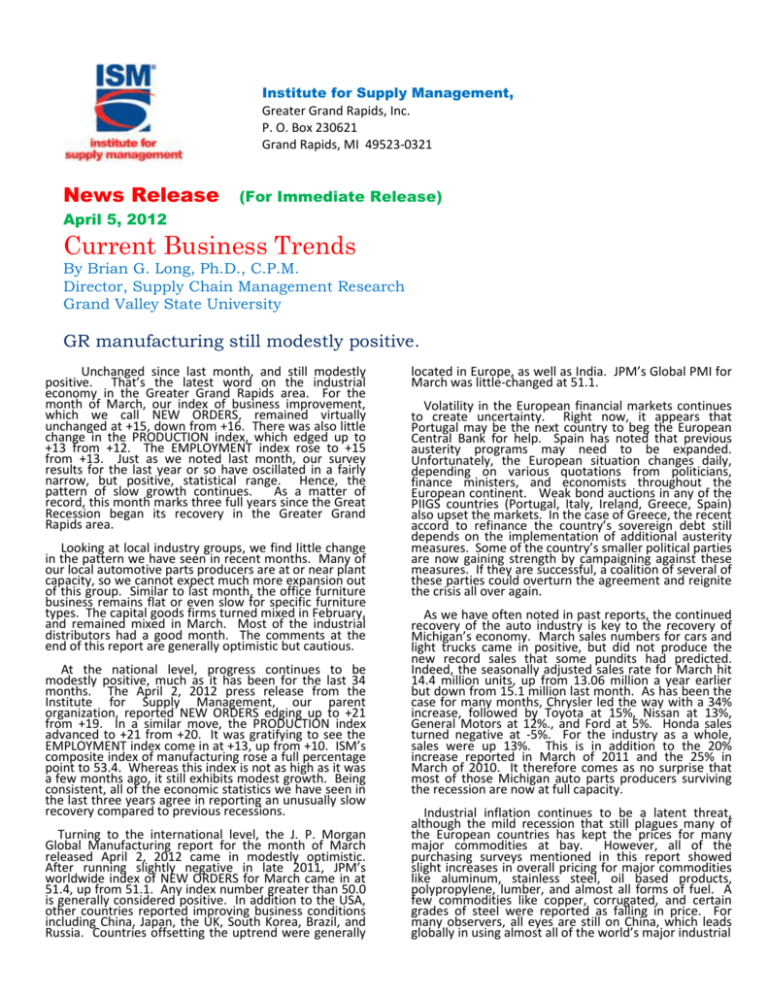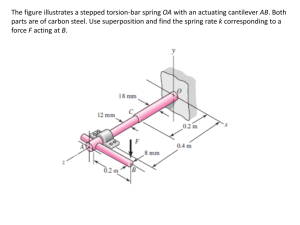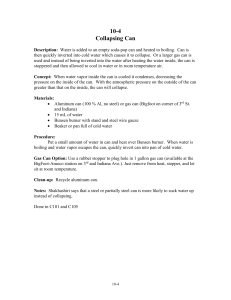Index of New Orders - Greater Grand Rapids
advertisement

Institute for Supply Management, Greater Grand Rapids, Inc. P. O. Box 230621 Grand Rapids, MI 49523-0321 News Release (For Immediate Release) April 5, 2012 Current Business Trends By Brian G. Long, Ph.D., C.P.M. Director, Supply Chain Management Research Grand Valley State University GR manufacturing still modestly positive. Unchanged since last month, and still modestly positive. That’s the latest word on the industrial economy in the Greater Grand Rapids area. For the month of March, our index of business improvement, which we call NEW ORDERS, remained virtually unchanged at +15, down from +16. There was also little change in the PRODUCTION index, which edged up to +13 from +12. The EMPLOYMENT index rose to +15 from +13. Just as we noted last month, our survey results for the last year or so have oscillated in a fairly narrow, but positive, statistical range. Hence, the pattern of slow growth continues. As a matter of record, this month marks three full years since the Great Recession began its recovery in the Greater Grand Rapids area. Looking at local industry groups, we find little change in the pattern we have seen in recent months. Many of our local automotive parts producers are at or near plant capacity, so we cannot expect much more expansion out of this group. Similar to last month, the office furniture business remains flat or even slow for specific furniture types. The capital goods firms turned mixed in February, and remained mixed in March. Most of the industrial distributors had a good month. The comments at the end of this report are generally optimistic but cautious. At the national level, progress continues to be modestly positive, much as it has been for the last 34 months. The April 2, 2012 press release from the Institute for Supply Management, our parent organization, reported NEW ORDERS edging up to +21 from +19. In a similar move, the PRODUCTION index advanced to +21 from +20. It was gratifying to see the EMPLOYMENT index come in at +13, up from +10. ISM’s composite index of manufacturing rose a full percentage point to 53.4. Whereas this index is not as high as it was a few months ago, it still exhibits modest growth. Being consistent, all of the economic statistics we have seen in the last three years agree in reporting an unusually slow recovery compared to previous recessions. Turning to the international level, the J. P. Morgan Global Manufacturing report for the month of March released April 2, 2012 came in modestly optimistic. After running slightly negative in late 2011, JPM’s worldwide index of NEW ORDERS for March came in at 51.4, up from 51.1. Any index number greater than 50.0 is generally considered positive. In addition to the USA, other countries reported improving business conditions including China, Japan, the UK, South Korea, Brazil, and Russia. Countries offsetting the uptrend were generally located in Europe, as well as India. JPM’s Global PMI for March was little-changed at 51.1. Volatility in the European financial markets continues to create uncertainty. Right now, it appears that Portugal may be the next country to beg the European Central Bank for help. Spain has noted that previous austerity programs may need to be expanded. Unfortunately, the European situation changes daily, depending on various quotations from politicians, finance ministers, and economists throughout the European continent. Weak bond auctions in any of the PIIGS countries (Portugal, Italy, Ireland, Greece, Spain) also upset the markets. In the case of Greece, the recent accord to refinance the country’s sovereign debt still depends on the implementation of additional austerity measures. Some of the country’s smaller political parties are now gaining strength by campaigning against these measures. If they are successful, a coalition of several of these parties could overturn the agreement and reignite the crisis all over again. As we have often noted in past reports, the continued recovery of the auto industry is key to the recovery of Michigan’s economy. March sales numbers for cars and light trucks came in positive, but did not produce the new record sales that some pundits had predicted. Indeed, the seasonally adjusted sales rate for March hit 14.4 million units, up from 13.06 million a year earlier but down from 15.1 million last month. As has been the case for many months, Chrysler led the way with a 34% increase, followed by Toyota at 15%, Nissan at 13%, General Motors at 12%., and Ford at 5%. Honda sales turned negative at -5%. For the industry as a whole, sales were up 13%. This is in addition to the 20% increase reported in March of 2011 and the 25% in March of 2010. It therefore comes as no surprise that most of those Michigan auto parts producers surviving the recession are now at full capacity. Industrial inflation continues to be a latent threat, although the mild recession that still plagues many of the European countries has kept the prices for many major commodities at bay. However, all of the purchasing surveys mentioned in this report showed slight increases in overall pricing for major commodities like aluminum, stainless steel, oil based products, polypropylene, lumber, and almost all forms of fuel. A few commodities like copper, corrugated, and certain grades of steel were reported as falling in price. For many observers, all eyes are still on China, which leads globally in using almost all of the world’s major industrial commodities such as steel, copper, lead, and zinc. The recent boom in the sale of motor vehicles, including cars, trucks, and mopeds, has resulted in new demand for motor fuels throughout the country. People ask if sustained $4 gas could throw us back into a recession. The simple answer is no. Over the past several years, many economists have used $4 per gallon as a tipping point. In other words, below $4, people generally complained a lot but continued their driving habits, and kept buying inefficient SUVs and trucks. At about $4 per gallon, large numbers of people start thinking fuel economy in many forms, such as shorter vacations, fewer recreational trips, car pooling, and so forth. They also start buying fuel efficient vehicles in greater quantities. Priorities in this country are such that consumers spend $15 billion per year on bottled water, and spend billions at Starbucks for morning coffee. Up to a limit, increased gas prices can be absorbed. After all the complaining is over, we reach new plateau "norm" such as $3 per gallon, but change our life styles very little. If we stay at $4 per gallon, the higher price will probably become the new norm, and people will build a life style around it. However, an increase to (heaven forbid) $6 per gallon would strain budgets such that the resulting economic crunch would mean a redefinition of our life style. like chemicals, plastics, steel, and most other metals, these charges can be substantial. These kinds of unexpected increases in the cost of doing business are difficult to pass along, and often have to be "absorbed." Of course, "absorbed" is another way of saying that an increase in fuels and freight costs may directly cut into profits. In the past, the price spikes have been relatively short lived, and many managers just hang on and hope the prices will come back to $3 or so-which they always have done in the past. Sustained higher prices will cut into corporate profits, which will depress the stock market or business confidence. Looking forward, we can expect continued volatility in the financial markets because of the European debt situation. It is unlikely that, over the next six months, European economic and/or political gyrations will be volatile enough to inhibit our economic growth. Excluding Greece, the European countries that have slid into negative growth will probably find that their recessions are fairly shallow. However, because of the European recession, our sales of goods and services to Europe will slow considerably, thus affecting our growth here at home. All of this assumes that wiser minds will prevail in the world geopolitical environment, and that some kind of a war does not break out in the Middle East. At the industrial level, what most survey respondents complain about is fuel surcharges. For bulky products ---------------------------------COMMENTS FROM SURVEY PARTICIPANTS “We’re busy, very busy, and expanding.” “So far, so good.” “Life is a lot better with business coming it. It’s more hectic, but better! I will take the "better!" “It’s like things are up, but I keep hearing that some are starting to slow down.” “Sales continue to hold steady as does our customer confidence.” “Things appear to be getting better after a soft start to the year. There still seems to be a lot of volatility in the market.” “Change is happening, and there is never a dull moment right now.” “Business is starting to pick up. The second quarter should be much busier.” “We received a 10% bump in orders in the second week of the month. Forecast remains strong!” “We had a strong start but a soft finish for the first quarter.” “Business is not getting any worse yet, but not getting any better, either!” “I think industrial America is slowing down, the opposite of what the news reports. Domestic car inventories are high, and gasoline cost is going to slow car sales. We are getting weaker, not stronger as the media keeps reporting.” “We are historically slow this time of year, but still seeing some bright spots in June.” “Business is picking up.” “It’s been an encouraging start of the year.” “The auto industry still seems to be the leader. Will $4.00 a gallon gasoline slow them down? We’re still concerned for long term planning and commitments. It is very difficult to get longer forecasts as everyone is playing it very close to the vest.” “We are doing well and contributing nicely to the greater GR economy.” “We’re still heavy on the quote side but holding steady on the order side.” “Some of our customers are beginning to slow down. Not a lot, but some are beginning to slow.” “Some customers are pushing out orders.” “Raw materials inventory is down on average by about 1% following forward buying activities in December, which increased inventories held in January and February that are now coming down in March. Sales are below our February average daily sales but remain strong and higher than last year, just not as strong as Jan. and Feb. We have no huge concerns, but are watching sales closely.” “Pricing of steel has come down a little after early year increases. The mills are trying to stop the decline in pricing. I think we are entering a few months of steady pricing.” “Manufacturing is moving slower. Steel lead times have shortened considerably, reflecting poor durable goods orders. Steel prices are down recently, but the mills will announce increases to buoy order book.” “Steel pricing appears to be softening.” “Demand is holding steady, but showing signs of softening in the short term.” “Miscellaneous items are in short supply due to spike purchases in a strong February, and also due to suppliers simply carrying less inventory.” “Our facility started our annual shutdown 12/31/2011 and will be down until mid April. Sales are slow.” “We had price increases from some suppliers because of labor and health care cost. Also, items and items that have Chinese labor in them.” “March is a little soft, but a fair amount of new tools are in the pipeline, so we are optimistic for late April and into May for new sales.” “The general first of the year price increases are still being negotiated because these costs are being passed on.” UP SAME DOWN N/A Mar. Index Feb. Index Jan. Index 20 Year Average Sales (New Orders) 36% 41% 21% 2% +15 +16 + 9 +29 Production 36% 36% 23% 5% +13 +12 + 7 +13 Employment 27% 61% 12% +15 +13 +26 + 8 Purchases 30% 54% 16% +14 + 6 +13 + 7 Prices Paid (major commod.) 34% 59% 5% 2% +29 +20 +30 +35 Lead Times (from suppliers) 14% 72% 12% 2% + 2 +18 +17 +11 Purchased Materials Inv. (Raw materials & supplies) 20% 60% 11% 9% + 9 + 7 + 2 - 5 Finished Goods Inventory 18% 55% 16% 11% + 2 + 7 + 4 -10 Items in short supply: Gears, electronic components, copper SMS steel, ductile iron castings, some AB electronic components, magnets, titanium dioxide. Prices on the UP side: Fuel, polypropylene, acetone, carbon steel fasteners, resins, freight, aluminum, stainless steel, oil based products, polypropylene, lumber, foam, some hardware, welding wire, industrial gases, paints, plasticizer, SEBS resin, titanium dioxide, engineered friction material, steel, special alloy metals, rare earth magnets, gasoline, trucks, fuels costs, fasteners, carbon black, polymers. Prices on the DOWN side: Steel, steel tubing, copper, corrugated. Index of New Orders - Greater Grand Rapids As the name implies, this index measures new business coming into the firm, and signifies business improvement or business decline. When this index is positive for an extended period of time, it implies that the firm or organization will soon need to purchase more raw materials and services, hire more people, or possibly expand facilities. Since new orders are often received weeks or even months before any money is actually paid, this index is our best view of the future. Latest Report +15 for the month of March, 2012 Previous Month +16 for the month of February, 2012 One Year Ago +38 for the month of March, 2011 Record Low -57 for the month of December, 2008 Record High +55 for the month of September, 1994 First Recovery +3 for April, 2009 and forward -70 2012 2011 2010 2009 2008 2007 2006 2005 2012 2011 2010 2009 2008 2007 2006 2005 2004 2003 2002 2001 2000 1999 1998 1997 1996 1995 1994 1993 1992 1991 1990 1989 Index of New Orders 1988 - 2012 70 50 30 10 -10 -30 -50 -70 Index of New Orders: 2005-2012 Only 70 50 30 10 -10 -30 -50







